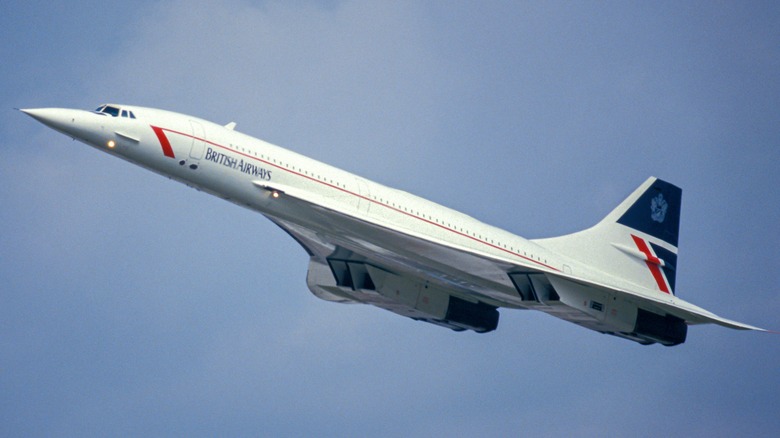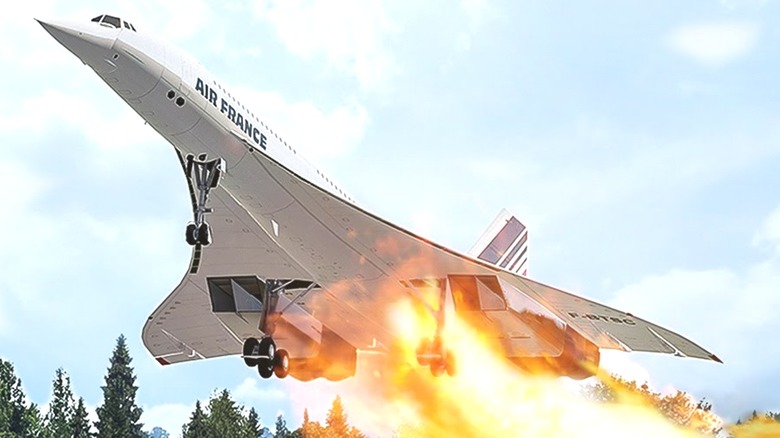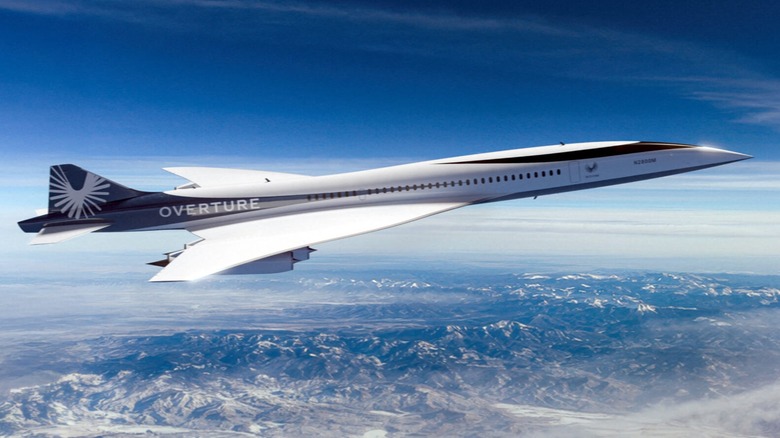Why Was The Concorde Discontinued & How Many Crashed When In Operation?
Of all the commercial aircraft that have been in operation since the beginning days of flight technology, the Concorde stands alone as the fastest and longest-serving supersonic airliner. The aircraft was jointly developed by British and French companies, which began producing the Concorde in 1965, though it would be several years before the aircraft would first take flight. In many ways, the Concorde jet was ahead of its time. It ceased operation in 2003.
When it was flying, the Concorde was the height of aviation luxury and speed. The plane could jet across the Atlantic Ocean in record time. It routinely flew from New York City to Paris in three and a half hours, though it once made the trip from London to New York in two hours and 52 minutes. For comparison, a standard subsonic passenger aircraft in 2025 takes more than seven and a half hours to fly from Paris to New York, so the Concorde's appeal is apparent.
Unfortunately, the Concorde is no more. The only places you can see these planes are in aviation museums across Europe and North America. The Concorde's time ended following the crash of Air France Flight 4590 on July 25, 2000. This was the only fatal crash in Concorde's history. When the Concorde was pulled from operation, it joined the group of major airplanes that were discontinued by their manufacturers. Since the Concorde's grounding, no supersonic passenger plane has risen in its place, making it an unusual plane in aviation history.
The crash that killed the Concorde
The Concorde was expensive to operate and out of the price range of most people (a round-trip ticket for a transatlantic flight cost about $12,000 in today's dollars), but that's not why it was retired. While costs were certainly factors in the airplane's retirement, it was the crash of Air France Flight 4590 that eventually killed the Concorde. The crash occurred almost immediately after takeoff from Charles de Gaulle Airport in Paris, France. The plane ran over a piece of metal debris from another aircraft, resulting in a tire explosion. Shrapnel and tire fragments shot upward, striking the wing from beneath while simultaneously damaging the remaining landing gear.
The gear couldn't retract, and a fuel tank ruptured, leaking highly flammable Jet A-1 (a type of kerosene) that ignited, killing the left-side engines. The plane lifted off and remained airborne for two minutes, but control was impossible. The Concorde crashed into a nearby hotel, resulting in the deaths of all nine crew members and 100 passengers. Four people in the hotel were also killed, and several others sustained injuries.
After the crash, the Concorde fleet was grounded. It was returned to service briefly in 2001. Its first flight with passengers happened the same day as the 9/11 attacks, and the financial blow the commercial airline industry took, coupled with the high cost of operations and the devastating crash, was the beginning of the end for the Concorde. This came long after the production of new Concordes ended in 1980. The manufacturers originally planned to produce several hundred Concordes, but only 20 were ever made. While the Concorde is out of the picture, a successor may one day take to the skies as its replacement.
The future of supersonic commercial air travel
The Concorde hasn't flown in decades, but there's still a commercial market for supersonic air travel. Because of sonic booms, it's mostly limited to transoceanic flights, but that still allows for a lot of travel between continents. One aircraft for which the Concorde paved the way is the Boom Overture, which is under development at Boom Technology. The plane began construction in 2024, and it is expected to be commercially available around the turn of the decade.
Boom Overture is being called "Son of Concorde," and that's largely due to its design mimicking its predecessor. Like the Concorde, the Boom Overture features a delta wing design and four powerful engines, and it will be able to carry up to 80 passengers. That's smaller than the Concorde's capacity, but given the cost of operation, it's unlikely the Boom Overture will have flight attendants asking you to give up your seat for someone else — it's going to be a very exclusive experience.
Regardless, plans are in motion, and the technology is there to make a new supersonic passenger plane. Should Boom Technology fulfill its desire to make the plane a reality, it will carve out a nice, untapped market. Ideally, the cost of a seat from New York to London will be $5,000, which isn't cheap, but it's significantly less than the Concorde. Several orders have already been placed, including Virgin Group's desire for 10 aircraft. Unlike the Concorde, the Boom Overture will aim for profitability on each run, whereas the Concorde's profitability was difficult to achieve and impossible to maintain.


